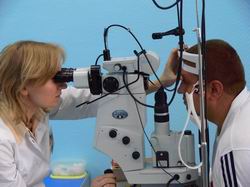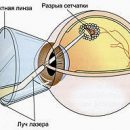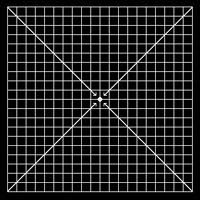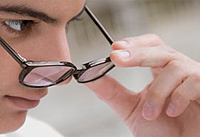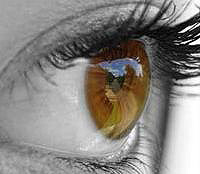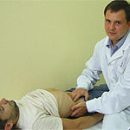The usual and faithful satellite of civilization - glasses. However, technical progress made it possible to many decisive people, whose eyes are poorly seen, get rid of glasses. What awaits those who fall under a laser beam?
Content
You have myopia? Everything is not so bad 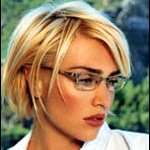
By the end of the twentieth century, according to the World Health Organization, poor eyesight turned out to be the problem of one third of the world's population. The connection of myopia, or myopia, with the need to look closely to the items, located immediately before our eyes, proved. Most adults are wearing glasses in Japan: as it turned out - due to the features of the writtenness of the Japanese, peering in the hieroglyphs and «breaking eyes».
Without glasses, many are not thinking of life: Fashion is followed by choosing a frame; work out the elegance of movements when they water it on the nose; confidently and with the meaning hide their windows into the case, if suddenly begins to smell like a fruit. But there are those who hate glasses, considering them «Optical crutches» and suffering from nickname «Changarik». Sometimes on objective medical testimony alternative to points. Nevertheless, everything is not so bad.
Back in 1939. Japanese eye doctor Tsuto Sato developed the basics of the so-called «radical keratotomy» - operations at the cornea of the eye are applied notches on radii to impart an eye «Lensee» optical properties that allow you to focus the image exactly on the retina, as it should be a person with good vision. Somewhat later, the method was tested: several patients were operated on. But frequent closures of the cornea and other dangerous complications suspended the development of the method proposed by the Japanese.
Only in 1972. Academician Svyatoslav Fedorov significantly improved the technique of eye surgery. Already by the middle of the eighties in the Moscow Center for Microsurgery, the eye equipped with the then the latest technology, keratotomy (mainly to fight myopia) did «conveyor» Method: Patient «Under the knife» Surgeon lay no more than twenty minutes, and from the operating room went out «on their two».
However, direct interference in the eye fabric - «Fedor's notches» - sometimes led to complications. In the eye surgery requires micron accuracy: only it provides good results and safety.
In 1976. The first excimer laser was created by IBM: so we called the device in which the ultraviolet laser beam form the molecules of a special chemical compound. The invention dictated the need that did not have attitude towards ophthalmology - it was necessary to engrave computer chips with jewelry accuracy. But doctors immediately became interested in new technology.
Further studies set: skillful use of an excimer laser beam harmlessly. And the ability to actually control the depth of its penetration gave prospects to apply a novelty just where the accuracy is above all, in the microsurgery of the eye.
The first laser vision correction was carried out in Berlin in 1985. The result turned out to be such that the new technology immediately received recognition of the leading «Eye glasses» Mira. Already since 1988. Laser correction began to practice in all the most famous ophthalmic centers of Europe and America.
High-precision weapon
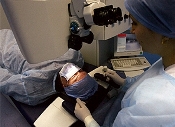 The essence of the correction of vision by the method of exposure to the laser ray is that «cold» The laser beam spotfully evaporates the thinnest layer of the cornea of the eye, changing her curvature. In this case, the refraction of light in the eye suffering, for example, myopia, somewhat changes: focus points are exactly on the retina - and items become clearly visible at different distances. The entire procedure is carried out outpatient, under local drip anesthesia. Painful sensations are completely absent. Laser exposure lasts 40-60 seconds. On the same day, the patient returns home.
The essence of the correction of vision by the method of exposure to the laser ray is that «cold» The laser beam spotfully evaporates the thinnest layer of the cornea of the eye, changing her curvature. In this case, the refraction of light in the eye suffering, for example, myopia, somewhat changes: focus points are exactly on the retina - and items become clearly visible at different distances. The entire procedure is carried out outpatient, under local drip anesthesia. Painful sensations are completely absent. Laser exposure lasts 40-60 seconds. On the same day, the patient returns home.
The main types of laser correction of view today - with the impact on the surface layers of the cornea or with a deeper penetration of the beam.
Thanks to this technology, radical treatment of violations of vision from the surgical region has passed more likely to the sphere of cosmetology medicine.
Laser beam affects only the necessary parts of the cornea. At the same time, he does not injure neighboring areas. The cornea of the eye now does not disseminate the scalpel: «Laser» The operating room that recently reminds not about surgery, but rather about physics.
Without pain
- What feels the patient during intervention, even if such a high-tech, in such a delicate organ like an eye?
- Within 3-4 hours after the operation, light discomfort: a feeling of a foreign body, a tear, light-in-friendly, - says Ophthalmoshurgerg Tatyana Mananylo. - But after this period, all unpleasant feelings go without a trace. A significant improvement in visual acuity occurs already on the day of operation.
Complete stabilization of vision after laser correction comes to the end of the first month. In this case, the patient has no need to significantly limit itself in physical and visual loads. After the operation, you can read, write, emit any food, watch TV, and even drive a car.
- With the correct compliance with the recommendations of the doctor, the probability of complications is zero, - concludes. Manuno.
Laser vision correction gave rise to a lot of myths. For example, there is an opinion that it is quite risky interference. Like the fact that the results of the correction can not be foreseen.
- According to the results of the diagnostic examination to the procedure itself, the doctor and the patient will recognize what vision will be after it, - assures Dr. Mananylo. - Modern techniques allow not only to study the surface of the cornea in detail, but also to predict how the eye will see in 10-15 years. If the patient at the preliminary consultation did not hide information from the doctor about the state of his health if ophthalmosurgeons work in the clinic with sufficient qualifications and it is equipped with modern high-precision equipment — There should be no complications.
In fairness it should be noted that not all doctors agree that the laser correction of vision is a panacea at myopia, hyperopia or astigmatism. Professor Nikolai Sergienko, Ophthalmoshururg, believes:
- For laser correction there is a strict list of readings and contraindications. Cannot be corrected with progressive impairment of vision. Before the operation, it is necessary to regularly observe regularly to establish whether myopia progresses. This requirement is rarely executed because patients want to operate as soon as possible. You can not make correction for children, people with a thin cornea, as well as those who wear glasses in more than 10 diopters.
- Over the past two years, there was no complications after laser correction, which cannot be said about the contact correction with the help of a scalpel, - Nikolai Sergienko says. - The main reason for complications - infection. And this is not one or two cases, and thousands.
The professor itself is wearing glasses, and says that he would never make a correction: «It is necessary to understand that there is nothing wrong with the glasses. Among all patients, the operation is really shown only 5-10%. These are athletes, some servicemen and those whom glasses interfere with professional activities. The rest - go on psychological or «cosmetic» Considerations. No wish among those who want to make a correction so many young women».

